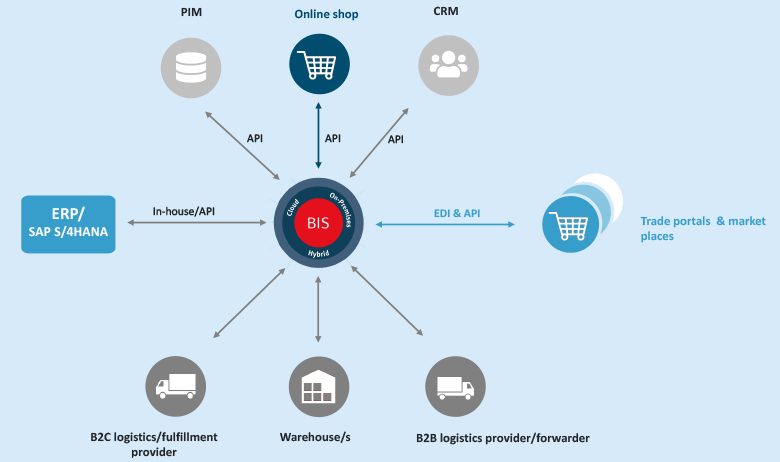
The first part of our blog series on systems integration for e-commerce was an e-commerce 101. The second part looked at the advantages of e-commerce and how you can maximise these through digitalization. The third article in the series contained seven practical tips for how to be successful at e-commerce. This fourth and final part of our blog series is all about integration.
The increasing importance of e-commerce and seamless integration
Are you starting from scratch with e-commerce or are you expanding current solutions for greater e-commerce success? There are many reasons for starting or expanding an e-commerce or online shop solution. These include:
- serving different target groups through concurrent sales channels,
- rapid expansion abroad by using digital sales channels,
- increased customer loyalty through giving them a better online shopping experience,
- central monitoring and control for orders and returns.
But how do you intelligently set up and expand an e-commerce system? Which of your current systems need to be integrated? What systems may you need in the future? How can you best combine and integrate old and new? If you deal with these questions before setting up your e-commerce modules, you will have already tackled the greatest hurdles to successfully implementing an e-commerce system. These days, e-commerce solutions can only be successful if all modules are seamlessly integrated.
What modules do you need to integrate into your e-commerce solution?
Do you hope to simply select a suitable shop solution and off you go? Unfortunately, it’s no longer that simple. If you want to offer B2B and B2C customers the best shopping experience, these days you need to do so much more.
One of the first things you need to consider is whether you will only have one e-commerce sales channel or whether, for example, it’d be better to have separate online shops for each target group. What about a further presence on large online marketplaces like Amazon, or a specialist industry trader? If you have a more comprehensive e-commerce strategy, you will want to look at how to make all product information available from a central point (such as a PIM system) and how to standardise delivery (e.g. via integrated fulfilment providers or logistics service providers) regardless of how the customer has placed an order. This creates a consistent shopping experience for your customers.
 Figure: Typical modules in an e-commerce solution
Figure: Typical modules in an e-commerce solutionCompanies are expanding their traditional sales channels with their own shop front or marketplace on online traders’ sites and connecting these to their ERP systems (e.g. SAP S/4HANA). Integrating a PIM (for master data on sales products) and CRM (for sales processing) is also important. In addition, you may well need to integrate fulfilment providers, warehouses and logistics providers. This will require a central integration platform such as the SEEBURGER Business Integration Suite as a data and process hub.
What are the most important performance indicators for your e-commerce solution?
The most important performance indicators for your online shop are page load times and the ability to scale up when large numbers of users want to access the shop at the same time. Nowhere are page load times so critically reviewed as in online shopping.
Have you ever tried to buy concert tickets and ended up sitting in front of a frozen website? Then you’ll know how frustrating it is when a shop cannot cope with a rush of visitors. Now imagine that the trouble-hit online shop is yours and it is your customers who are angry, frustrated and/or already on their way to the competition. No matter how high the load is, your online shop should run stably at all times and offer your customers a consistently positive shopping experience. So don’t just plan based on expected average visitor numbers, but also factor in possible seasonal or event-related spikes. And remember that all the e-commerce modules connected to the shop also contribute to the overall performance of the solution. Seamless integration is key.
Why do you need real-time information updates?
The days when customers ordered something and waited dutifully for a fortnight until the goods arrived are long gone. Today, orders are placed on the go and payment details are immediately synchronised with a banking app. The customer chooses the courier, tracks the delivery in real time and may even specify a time slot for the parcel to arrive. Nowhere is real time information as essential as in e-commerce. These days, anyone ordering online expects to be able to call up full information about their order at any time – a service that has long been impossible to provide manually. To enable this, all steps in the delivery process need to be integrated in a track and trace system.
Seamlessly integrate all your e-commerce modules to meet customer expectations.
Whatever e-commerce modules your company chooses to implement their strategy, the same applies. They must be integrated seamlessly and in real time. Let’s take a look at an example:
A medium-sized cosmetics manufacturer has enjoyed global success through innovative brand concepts and multiple digital sales strategies. In order to expand its international business and also enable end customers to buy directly from the manufacturer around the clock, this company decided to set up its own online shops. Following the dual launch of B2B and B2C online shops, the company has since increased customer loyalty and expanded its international B2B business to another 40 countries. This was only possible by seamlessly integrating all the e-commerce modules, including
- digitalized order processing with all major trading partners worldwide,
- central integration of, for example, customer and order details into SAP ERP,
- efficient monitoring and supervision of goods flow,
- digital returns management through seamless SAP integration and in some cases real-time synchronisation of data from merchandise management and fulfilment service providers,
- Tablet commerce connecting local business partners for ad-hoc contracts
- Connection of further systems, such as a PIM system to make the online shop available in multiple languages.
Get your systems working with one another
Seamless integration is the be-all and end-all in e-commerce. A customer who has been on the company website to enter all his personal details for his account will not be impressed if the shop’s app cannot access this information. Companies with many different e-commerce modules in particular should ensure that these can interact with each other. Instead of networking each system module one by one to each other, it is better to use an integration platform. This acts as a central platform for all communication between the connected systems.
How can SEEBURGER help you?
Does your company already have an e-commerce arm, or are you planning to implement this in the future? Regardless of whether you offer products, goods or services, implementing an e-commerce strategy and choosing the right e-commerce modules is a complex task. It requires experience – either your own, or of an experienced partner. SEEBURGER supports you in integrating your e-commerce applications and business processes into your entire ecosystem – on-premises or in the cloud, and completely tailored to your needs. SEEBURGER offers you an integration solution that is as individual as your business. Contact us today!
Source: https://blog.seeburger.com/b2b-e-commerce-part-4-intelligent-systems-integration-in-e-commerce/
 expertise
expertise
